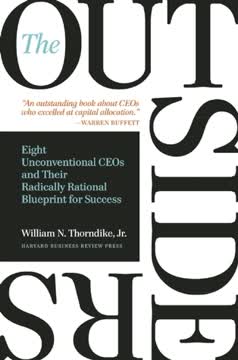Key Takeaways
1. The Halo Effect: Perceptions Colored by Performance
Many things we commonly believe lead to company performance — corporate culture, leadership, and more — are often simply attributions based on company performance.
The Halo Effect is a cognitive bias that significantly influences how we perceive successful companies. When a company performs well financially, we tend to attribute positive qualities to various aspects of the organization, such as:
- Leadership: Executives are seen as visionary and charismatic
- Culture: The company is perceived to have a strong, positive culture
- Strategy: Business decisions are viewed as brilliant and well-executed
- Customer focus: The organization is thought to be highly attuned to customer needs
Conversely, when performance declines, these same attributes are often viewed negatively. This effect makes it challenging to accurately identify the true drivers of success or failure.
2. Correlation vs. Causation: A Critical Distinction
Even if we avoid the Halo Effect, and even if we conduct a longitudinal study, we still have the problem of alternate explanations.
Mistaking correlation for causation is a common pitfall in business analysis. Many studies show correlations between certain practices and company performance, but fail to establish causality. Key considerations:
- Temporal sequence: Did the practice precede the performance improvement?
- Alternative explanations: Could other factors be responsible for the observed effect?
- Reverse causality: Might good performance enable the adoption of certain practices, rather than the other way around?
To avoid this delusion, managers should:
- Look for evidence of causal mechanisms
- Consider multiple explanations for observed correlations
- Be skeptical of simple cause-and-effect claims in complex business environments
3. The Delusion of Single Explanations in Business Success
Every one of these studies looks at a single explanation for firm performance and leaves the others aside.
Complex interplay of factors contributes to business success, not single, isolated elements. Many popular business books and studies fall into the trap of oversimplification by focusing on one factor, such as:
- Leadership style
- Corporate culture
- Innovation practices
- Customer orientation
In reality, these factors are often interconnected and mutually reinforcing. A more nuanced approach recognizes that:
- Multiple factors contribute to success simultaneously
- The relative importance of factors may vary by industry, company size, and market conditions
- Success often results from the synergy between different elements, not their individual effects
4. The Myth of Lasting Success and Enduring Greatness
Enduring greatness is neither very likely, nor, when we find it, does it tend to be associated with high performance.
Sustained high performance is extremely rare in the business world. Key insights:
- Most companies experience periods of success followed by decline
- Out of 1,435 companies studied over 40 years, only 74 remained in the S&P 500, and only 12 outperformed the market
- "Built to Last" companies often underperformed after being identified as great
Reasons for this pattern:
- Competitive pressures erode advantages over time
- Disruptive technologies can upend established players
- Market conditions and consumer preferences change
- Success can lead to complacency or resistance to change
Managers should focus on adaptability and continuous improvement rather than seeking a formula for permanent success.
5. Relative Performance: Success in a Competitive Landscape
Company performance is relative, not absolute. A company can improve and fall further behind at the same time.
Success is inherently relative in the business world. Key points:
- Improving in absolute terms doesn't guarantee success if competitors are improving faster
- Market share and profitability depend on performance relative to competitors
- Industries evolve, raising the bar for what constitutes good performance
Example: Kmart improved many aspects of its operations but still fell behind Walmart and Target, ultimately leading to bankruptcy.
Implications for managers:
- Continuously benchmark against competitors
- Focus on building sustainable competitive advantages
- Anticipate industry trends and evolving customer expectations
6. The Danger of Attributing Success to Specific Factors
It may be true that successful companies often pursued a highly focused strategy, but that doesn't mean highly focused strategies often lead to success.
The danger of reverse logic in business analysis is prevalent. Many studies identify common traits among successful companies and incorrectly conclude that these traits cause success. This "Delusion of Connecting the Winning Dots" overlooks:
- Survivorship bias: We only see the successful companies, not the failures
- Selection bias: Choosing companies based on outcomes skews results
- Lack of comparison: Not examining less successful companies with similar traits
A more rigorous approach would:
- Study a broad range of companies, including failures
- Examine how frequently certain traits lead to success or failure
- Consider the context and timing of strategic decisions
7. Strategy and Execution: The Two Pillars of Performance
If we set aside the usual suspects of leadership and culture and focus and so on — which are perhaps better understood as attributions based on performance rather than causes of performance — we're left with two broad categories: strategic choice and execution.
Strategy and execution form the core of business performance. Key aspects:
Strategy:
- Choosing which markets to compete in
- Deciding on product/service offerings
- Positioning relative to competitors
Execution:
- Implementing chosen strategies effectively
- Managing day-to-day operations
- Continuously improving processes and capabilities
Both elements involve uncertainty and risk. Successful companies excel at:
- Making informed strategic choices based on market analysis
- Adapting strategies as conditions change
- Implementing strategies with discipline and flexibility
- Measuring and improving execution continuously
8. Embracing Uncertainty: The Reality of Business Decision-Making
Wise managers know that business is about finding ways to improve the odds of success — but never imagine that success is certain.
Uncertainty is inherent in business decision-making. Key insights:
- No strategy or execution plan guarantees success
- External factors (market changes, competitor actions, technological shifts) introduce unpredictability
- Internal capabilities and limitations add complexity
Effective managers:
- Gather and analyze relevant information
- Consider multiple scenarios and potential outcomes
- Make calculated risks based on probabilities, not certainties
- Remain flexible and adapt as new information emerges
- Learn from both successes and failures
9. The Limits of Business Formulas and "Laws"
Anyone who claims to have found laws of business physics either understands little about business, or little about physics, or both.
Beware of simplistic formulas for business success. Unlike physics, business doesn't operate according to immutable laws. Key reasons:
- Human behavior introduces unpredictability
- Market conditions constantly evolve
- Complex interactions between multiple variables
- Unique contexts for each company and industry
Instead of seeking universal laws, managers should:
- Develop critical thinking skills
- Analyze each situation in its specific context
- Learn from past experiences but avoid blind application of "rules"
- Remain open to new ideas and approaches
10. Critical Thinking: Essential for Wise Management
I'd like this book to help managers become wiser: more discerning, more appropriately skeptical, and less vulnerable to simplistic formulas and quick-fix remedies.
Developing critical thinking skills is crucial for effective management. Key aspects:
- Questioning assumptions and conventional wisdom
- Evaluating evidence and claims rigorously
- Considering alternative explanations and perspectives
- Recognizing cognitive biases and logical fallacies
Practical steps for managers:
- Seek out diverse sources of information and viewpoints
- Encourage constructive debate and challenge within teams
- Regularly review and update mental models and beliefs
- Embrace complexity and nuance in business analysis
- Cultivate intellectual humility and openness to new ideas
By developing these skills, managers can navigate the complex business landscape more effectively and make better-informed decisions.
Last updated:
FAQ
What's The Halo Effect about?
- Explores business delusions: The Halo Effect by Philip M. Rosenzweig examines common misconceptions in business management, focusing on how the Halo Effect leads to misattributions about company performance.
- Questions success and failure: It delves into why some companies succeed while others fail, highlighting that many perceived success drivers are often just attributions based on prior performance.
- Encourages critical thinking: The book urges managers to think critically and independently, challenging popular business narratives and expert advice.
Why should I read The Halo Effect?
- Challenge conventional wisdom: The book offers a fresh perspective on business success, encouraging readers to question widely accepted management beliefs and practices.
- Improve decision-making: By understanding the delusions that cloud judgment, readers can make more informed and rational decisions in their organizations.
- Real-world examples: It uses case studies from companies like Cisco and ABB to illustrate the pitfalls of misattributing success and failure.
What are the key takeaways of The Halo Effect?
- Beware of the Halo Effect: Many attributions about company performance are influenced by prior success, leading to flawed conclusions about what drives that success.
- Correlation vs. causation: The book stresses the importance of distinguishing between correlation and causation, as many studies fail to do so, leading to misleading interpretations.
- Delusions in business thinking: It identifies several delusions, such as the Delusion of Single Explanations and the Delusion of Lasting Success, which can hinder effective management.
What is the Halo Effect as defined in The Halo Effect?
- General impression influences specifics: The Halo Effect refers to the tendency to make inferences about specific traits based on an overall impression, such as assuming a company with good financial performance also has a strong culture.
- Cognitive bias: This bias simplifies complex evaluations, making it difficult to assess individual attributes independently.
- Impact on business decisions: It can lead managers to misattribute success to factors like leadership or culture, rather than recognizing the role of external circumstances or market conditions.
How does The Halo Effect critique popular business books?
- Flawed research methods: The book argues that many popular business books rely on anecdotal evidence and flawed research methods susceptible to the Halo Effect.
- Overgeneralization of success factors: These books often present a narrow view of what leads to success, ignoring the complexity and variability of business environments.
- Encourages critical analysis: The critique serves as a call for readers to approach such books with skepticism and seek a deeper understanding of performance factors.
What are some examples of companies discussed in The Halo Effect?
- Cisco Systems: The book discusses Cisco's rise and fall, illustrating how its initial success led to overconfidence and misattributions about its customer focus and management practices.
- ABB: ABB is used as a case study to show how perceptions of success can change dramatically based on performance, highlighting the role of leadership and corporate culture.
- Lego: The author examines Lego's struggles, emphasizing how the narrative around its performance shifted based on its financial results, demonstrating the Halo Effect in action.
What is the Delusion of Correlation and Causality in The Halo Effect?
- Misinterpretation of data: This delusion refers to the common mistake of assuming that correlation between two variables implies causation without sufficient evidence.
- Example of employee satisfaction: The book discusses how studies often show a correlation between employee satisfaction and company performance, but it may be that high performance leads to greater satisfaction instead.
- Need for rigorous research: The author stresses the importance of conducting research that can accurately determine causality rather than relying on superficial correlations.
How does The Halo Effect address the Delusion of Lasting Success?
- Temporary nature of success: The book argues that many companies that appear successful over time often experience declines, challenging the notion of enduring greatness.
- Historical examples: It cites studies showing that a significant percentage of companies that were once leaders have fallen from grace, illustrating business success volatility.
- Encourages humility: The author suggests that managers should remain humble and recognize that success can be fleeting, rather than assuming past performance guarantees future results.
What is the "4+2 Formula" mentioned in The Halo Effect?
- Definition of the formula: The "4+2 Formula" identifies four primary practices (strategy, execution, culture, and structure) and two additional practices (talent and leadership) that correlate with business success.
- Critique of the formula: The author argues that while these practices may be associated with high performance, they do not guarantee success, as context and competitive environment play crucial roles.
- Caution against oversimplification: The book warns against viewing this formula as a blueprint for success, emphasizing that performance is influenced by multiple factors.
What are the best quotes from The Halo Effect and what do they mean?
- “The central idea in this book is that our thinking about business is shaped by a number of delusions.” This quote encapsulates the book's premise that misconceptions can cloud judgment and decision-making in business.
- “Success in business is as elusive as ever.” This highlights the complexity of achieving and maintaining success in a rapidly changing business environment, emphasizing that there are no simple formulas.
- “If you think your strategy is foolproof, the fool may well be you.” This serves as a caution against overconfidence in strategic decisions, urging managers to remain aware of inherent risks.
How can I apply the lessons from The Halo Effect in my own business?
- Critical evaluation of performance: Regularly assess your company's performance metrics without letting past successes cloud your judgment about current practices and strategies.
- Avoid simplistic explanations: When analyzing what drives your company's success, consider multiple factors and avoid attributing performance to a single cause or leader.
- Foster a culture of inquiry: Encourage open discussions and critical thinking among your team to challenge assumptions and explore the complexities of your business environment.
How does the book address the concept of strategic choice?
- Risky nature of strategic choices: The book discusses how strategic decisions involve significant risks, as they are based on predictions about customer behavior, competitor actions, and technological changes.
- Importance of context: It emphasizes that the effectiveness of a strategy is not only determined by its design but also by the competitive landscape and market conditions.
- Need for adaptability: The author advocates for a flexible approach to strategy, encouraging managers to be prepared to pivot in response to changing circumstances.
Review Summary
The Halo Effect challenges popular business beliefs, arguing that success cannot be reduced to simple formulas. Rosenzweig critiques best-selling management books, exposing flaws in their research methods and conclusions. He emphasizes the complexity of business success, highlighting the roles of strategy, execution, and chance. Readers appreciate the book's critical approach, praising its insights on cognitive biases and the limitations of retrospective analysis in understanding company performance. Many consider it essential reading for managers and business students, offering a refreshing perspective on organizational success.
Similar Books









Download PDF
Download EPUB
.epub digital book format is ideal for reading ebooks on phones, tablets, and e-readers.




